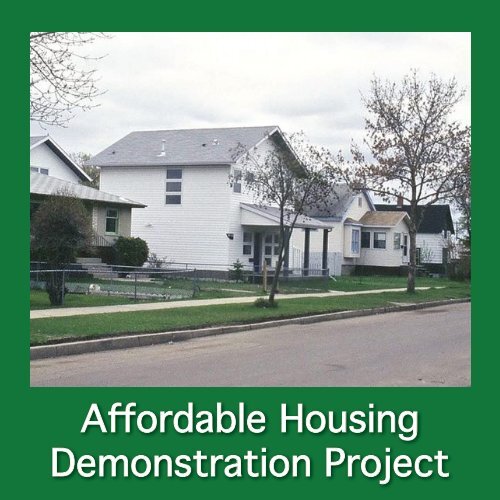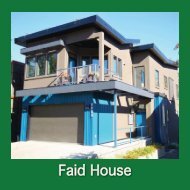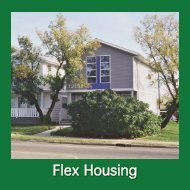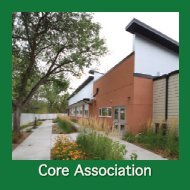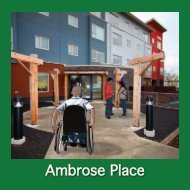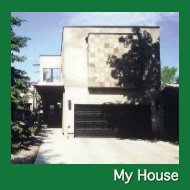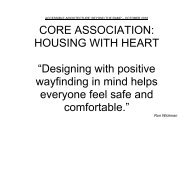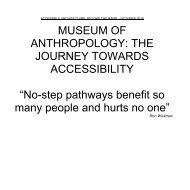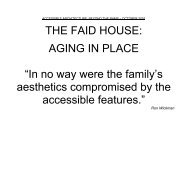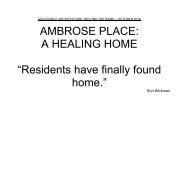AffordableHousingDemonstrationProject
Create successful ePaper yourself
Turn your PDF publications into a flip-book with our unique Google optimized e-Paper software.
Affordable Housing<br />
Demonstration Project
ACCESSIBLE ARCHITECTURE: BEYOND THE RAMP – OCTOBER 2016<br />
The above image shows the completed tri-plex.<br />
The design represents modernization of the prairie ideal house with its repeated window pattern<br />
and other geometric architectural detailing. Emphasis is on affordability, a simple foundation and<br />
roof and siding. The porch at the front of the two - story house reaches out into the street, facilitating<br />
street life and making it and its residents more a part of the community by enabling them to access<br />
it directly, even to sit outside.<br />
83
ACCESSIBLE ARCHITECTURE: BEYOND THE RAMP – OCTOBER 2016<br />
Winner of The Affordable Housing Demonstration Project in 1994, the tri-plex was the result of an<br />
open competition, initiated by the City of Edmonton Planning and Development and the Innovative<br />
Housing Committee. Its goal was to provide affordable and innovative duplex and triplex solutions<br />
for an inner city lot 35’-0” wide by 120’-0” long. Completed in the fall of 1995, it is still fully occupied.<br />
“This concept is a winner. It has a simple yet livable design<br />
and makes innovative use of the site. The courtyard<br />
encourages interaction, while the separate buildings allow<br />
natural light into the neighbor’s yard and allow for good<br />
amenity space. The unit facing the street is like a singlefamily<br />
home with an inviting veranda in the front. The<br />
barrier-free unit is a good feature. Overall, this design sets<br />
a good precedent.”<br />
The Jury<br />
84
ACCESSIBLE ARCHITECTURE: BEYOND THE RAMP – OCTOBER 2016<br />
The above color-rendered site plan drawing highlights the landscaping and color contrast around<br />
and between buildings. The project houses an inner south-facing outdoor courtyard space<br />
measuring approximately 24’-0” by 24’-0” onto which each dwelling looks. Everyone is free to utilize<br />
this space, a move designed to promote social interaction, bringing people together rather than<br />
keeping them apart.<br />
Local architects and homebuilders were invited to design affordable, innovative housing for a cityowned<br />
lot at Baldwin at 12673 – 72 Street, allowing more flexible land use. Each housing unit had<br />
to be priced below $86,000. At least one unit had to be suitable for families with children. Eight local<br />
teams of architects, designers, and builders submitted proposals that included two or three units of<br />
housing on the site. The five-person jury considered each entry’s affordability, effective design,<br />
livability, neighborhood fit, and innovation. In the project’s jury report, Edmonton architect David<br />
Murray noted “the two-building concept allows more light to reach the neighbor’s yard.”<br />
85
ACCESSIBLE ARCHITECTURE: BEYOND THE RAMP – OCTOBER 2016<br />
The above drawing identifies the main floor plan complete with the ground floor of the two-story<br />
home and the ground floor accessible dwelling. The resident of the accessible dwelling can visit the<br />
other home from the back door facing the courtyard where there is a no-step entrance.<br />
A simple flow-through circulation pattern is enabled with the absence of hall in the plan. This<br />
deliberate omission facilitates accessibility. Efficient use of space characterizes all of my designs.<br />
No doubt it is an offshoot of designing to accommodate wheelchairs. Clients in chairs and with other<br />
disabilities necessitate the incorporation of extra space into the bathroom, kitchen, and master<br />
bedroom.<br />
The project was designed to accomplish several important goals not usually addressed in<br />
Edmonton’s housing market. It had to accommodate low-income families, single parents, shared<br />
accommodations, seniors, and individuals with disabilities. Its flexibility allows one family to occupy<br />
both buildings, encouraging multi-generational housing: extended households, which include<br />
grandparents, young families with children or young adults living independently with disabilities.<br />
Alternatively, two families can each occupy a building, or three separate families can inhabit each<br />
unit.<br />
86
ACCESSIBLE ARCHITECTURE: BEYOND THE RAMP – OCTOBER 2016<br />
The above drawing identifies the second floor plan of the two buildings. With limited circulation<br />
space within the units – the smaller unit is 24’-0”by 24’-0” or 576 sq. ft. and the two-story unit is 24’-<br />
0” by 32’-0” or 768 sq. ft. – allows for critical larger closet and storage space.<br />
The integration of a courtyard into the design promotes social interaction rather than isolation. With<br />
an aging population and reduced institutional care for the elderly, the idea of an accessible granny<br />
suite like this project offers is timely.<br />
Efficient use of space characterizes all of my designs. No doubt it is an offshoot of designing to<br />
accommodate wheelchairs. Clients in wheelchairs and with other disabilities necessitate the<br />
incorporation of extra space, especially in the bathroom, kitchen and master bedroom.<br />
87
ACCESSIBLE ARCHITECTURE: BEYOND THE RAMP – OCTOBER 2016<br />
The above image shows the integration of this housing project into its existing neighborhood.<br />
It can be seen as an illustration of successful community infill, encouraging inner - city communities,<br />
which are often deserted as urban development continues in the suburbs. In my housing models, I<br />
try to provide for both privacy and socialization. The future of accessible design in the community<br />
is accessible community design: creating communities that are more accessible for everyone. This<br />
design fits into the existing streetscape, yet at the same time sets the tone for what future<br />
development could look like.<br />
88
ACCESSIBLE ARCHITECTURE: BEYOND THE RAMP – OCTOBER 2016<br />
Features like on-grade access, open floor plans, a lower kitchen counter, lever door handles, grab<br />
bars, accordion closet doors, and adjustable rod and shelf heights all help a variety of individuals.<br />
The strategic uses of color and contrast plus changes in texture of ground and wall surfaces serve<br />
as visual and tactile cues for those persons with visual and cognitive limitations.<br />
At an open house for the general public, many visitors commented that the project would work well<br />
for extended families. One woman considered that it would be perfect for her family, in which both<br />
her sister and she take care of their aging mother. Currently, each drives from their home to their<br />
mom’s house. This project would allow mom to live in the accessible dwelling and the sisters to live<br />
in the other two dwellings. While enjoying their privacy, they would be within seconds of each other<br />
in the event of an emergency.<br />
As architect Bjarke Ingels (Yes is More) wrote in a recent interview, “The task of a city is a practical<br />
one: to accommodate many people from all kinds of different backgrounds, age groups, social<br />
groups, economic capacities, genders, religions, and so on. It has to enable them to co-habit a<br />
limited amount of space successfully, in a way that maximizes the possibilities for each individual,<br />
without limiting the possibilities for all the others.”<br />
This project designed with sustainability, adaptability, and flexibility makes it suitable housing for<br />
seniors and for people with disabilities. Their maximization of space, incorporation of light and<br />
proximity to the amenities typical of inner-city housing enables the residents to age in place, a<br />
growing concern among the number of seniors among us. Community, rather than isolation, is an<br />
essential ingredient of their continued vigor and mental health, despite their abilities.<br />
89
ACCESSIBLE ARCHITECTURE: BEYOND THE RAMP – OCTOBER 2016<br />
The above image shows the street facing home complete with the address sign of high contrast<br />
white and black lettering.<br />
90
ACCESSIBLE ARCHITECTURE: BEYOND THE RAMP – OCTOBER 2016<br />
The above image shows the kitchen area of the ground level accessible dwelling.<br />
Most of the counter height is the standard 3’-0” from the floor. A lower counter, which is open<br />
underneath extends into the living space. The counter can serve as a workspace and eating area<br />
for someone sitting in a wheelchair. The sink is open underneath for easy wheelchair access.<br />
91


